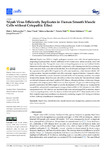Nipah Virus Efficiently Replicates in Human Smooth Muscle Cells without Cytopathic Effect
DeBuysscher, Blair L.
Scott, Dana P.
Rosenke, Rebecca
Wahl, Victoria
Feldmann, Heinz
Prescott, Joseph
Nipah virus (NiV) is a highly pathogenic zoonotic virus with a broad species tropism,
originating in pteropid bats. Human outbreaks of NiV disease occur almost annually, often with
high case-fatality rates. The specific events that lead to pathogenesis are not well defined, but the
disease has both respiratory and encephalitic components, with relapsing encephalitis occurring in
some cases more than a year after initial infection. Several cell types are targets of NiV, dictated by
the expression of the ephrin-B2/3 ligand on the cell’s outer membrane, which interact with the NiV
surface proteins. Vascular endothelial cells (ECs) are major targets of infection. Cytopathic effects
(CPE), characterized by syncytia formation and cell death, and an ensuing vasculitis, are a major
feature of the disease. Smooth muscle cells (SMCs) of the tunica media that line small blood vessels
are infected in humans and animal models of NiV disease, although pathology or histologic changes
associated with antigen-positive SMCs have not been reported. To gain an understanding of the
possible contributions that SMCs might have in the development of NiV disease, we investigated the
susceptibility and potential cytopathogenic changes of human SMCs to NiV infection in vitro. SMCs
were permissive for NiV infection and resulted in high titers and prolonged NiV production, despite
a lack of cytopathogenicity, and in the absence of detectable ephrin-B2/3. These results indicate that
SMC might be important contributors to disease by producing progeny NiV during an infection,
without suffering cytopathogenic consequences.
Files in this item

